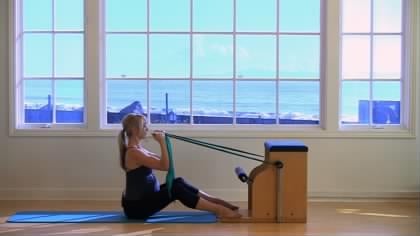Safe Prenatal Wunda Chair
Leah Stewart
Class 319
Watch this Class


Denee D
This was a beautiful class. It really helps me so much and I will put it to good use. Thank you Leah
11 years ago
I felt like there was a tonne of lumbar flexion/abdominal exercises. I'm pregnant and a pilates instructor and am not sure why this is a focus in the workout? I love your classes so am really curious to hear your advice on how you avoid diastasis when engaging your rectus so much in this workout and what your thoughts are around why do ab work at other than TA strengthening when pregnant?
11 years ago
Ali,
You ask a great question. The truth is there is a lot of confusion and fear around using the abdominals during pregnancy. And to boot, there is not a lot of great research to support theories. To go into a full explanation is not possible in this forum, but I hope to provide some answers for you.
When you asked this question I had literally just finished documenting this class in full detail days before. I had wrote out each exercise for my own records. I do about 34 exercises in this class. 5 of those exercises are "abdominal" exercises with lumbar flexion (I did not count the 3 warm up exercises with pelvic tilts and torso circles). 5 out of 34 exercises is 15% of the total class, which does not make it the focus or emphasis of the class. The class offers wonderful leg, arm, back, stretch and side work as well. It really is a full body class.
(this is long answer, so it'll have to be put into several posts)
You ask a great question. The truth is there is a lot of confusion and fear around using the abdominals during pregnancy. And to boot, there is not a lot of great research to support theories. To go into a full explanation is not possible in this forum, but I hope to provide some answers for you.
When you asked this question I had literally just finished documenting this class in full detail days before. I had wrote out each exercise for my own records. I do about 34 exercises in this class. 5 of those exercises are "abdominal" exercises with lumbar flexion (I did not count the 3 warm up exercises with pelvic tilts and torso circles). 5 out of 34 exercises is 15% of the total class, which does not make it the focus or emphasis of the class. The class offers wonderful leg, arm, back, stretch and side work as well. It really is a full body class.
(this is long answer, so it'll have to be put into several posts)
11 years ago
......Yes, the rectus will be engaged during these particular abdominal exercises, but so will the TA along with the obliques in some instances, as well as the pelvic floor and deep spinal extensors to provide additional support. The rectus here is not engaged in a max contraction (it can't be due to it's positioning during pregnancy), which helps to mitigate chances of a diastasis. Plus, the type of flexion being done here does not place excessive pressure on the abdominal wall (a believed contributor of diastasis when it comes to exercise) like traditional supine Pilates abdominal exercises, which we of course omit in a prenatal program.
The lumbar flexion in these exercises provide wonderful pelvic floor strengthening and health, PS and SI stabilization as well as mobilization of the lumber spine for relief of the tightness that so many pregnant women experience, especially late in pregnancy.
(continued in next post)
The lumbar flexion in these exercises provide wonderful pelvic floor strengthening and health, PS and SI stabilization as well as mobilization of the lumber spine for relief of the tightness that so many pregnant women experience, especially late in pregnancy.
(continued in next post)
11 years ago
.....In the other "non-abdominal" exercises in this class (footwork, arm work, side work) the TA along with the other abdominals in some cases, pelvic floor and deep spinal extensors are used to provide additional support and stabilization; providing ample TA strength maintenance through out the class.
And just to mention it, there is a theory out there that believes that pregnant woman should not do any TA activation or strengthening during pregnancy because it directly leads to a diastasis. There's a lot of differing opinions, theories and beliefs out there, you just may get a different answer from everybody
(continued in next post)
And just to mention it, there is a theory out there that believes that pregnant woman should not do any TA activation or strengthening during pregnancy because it directly leads to a diastasis. There's a lot of differing opinions, theories and beliefs out there, you just may get a different answer from everybody

(continued in next post)
11 years ago
.....According the minimal research, my many interviews with PTs and health care professionals and from my own experiences with teaching pregnant women and performing these exercises on my own body when pregnant, it's not so much about never engaging the rectus and only the TA (which is just not practical in functional, everyday movements which can include all of the abdominal muscles) it's about discovering ways to keep the whole of the abdominals, including the rectus, conditioned for a healthy pregnancy, labor and postpartum healing. It's about discovering ways to safely and healthfully engage the abdominals without placing excessive, undue pressure on the abdomen (this includes more than just TA exercises) and my experience and knowledge support that these exercises can provide that.
I did not experience a diastasis with my first pregnancy (now I am 5 months pregnant again and everything is good) and many of my clients have not either.
(continued in next post)
I did not experience a diastasis with my first pregnancy (now I am 5 months pregnant again and everything is good) and many of my clients have not either.
(continued in next post)
11 years ago
....But the truth is, the causes and reasons for a diastasis are really complicated and mostly have to do with uncontrolled conditions like tissue laxity (of the linea alba) and controlled conditions like the condition of the abdominals prior to pregnancy. Yes, excessive exercise can exacerbate a diastasis, when exericse in general when done incorrectly. But so can lifting heavy objects without support, genetics, etc. It's difficult to "blame" a diastasis on exercise alone.
In saying all this, I believe that if a woman (or an Pilates professional) does not feel comfortable performing an exercise/s or if they cannot perform the exercise/s with control, integrity, form, confidence and clarity, they should not do them, even the ones that are modified and considered safe.
(continued in next post)
In saying all this, I believe that if a woman (or an Pilates professional) does not feel comfortable performing an exercise/s or if they cannot perform the exercise/s with control, integrity, form, confidence and clarity, they should not do them, even the ones that are modified and considered safe.
(continued in next post)
11 years ago
....The bottom line is that it has to be done correctly and the client (and professional) has to feel good about it. There are plenty of great prenatal exercises for the entire body, the options are truly endless.
Ali, I hope that this helps a bit It's a complex topic that again has so many different answers and opinions. But I cannot emphasis enough that the client and the professional both need to help confident and clear when they do any exercise. Please let me know if you have any additional questions. I'm always happy to help in any way that I can.
It's a complex topic that again has so many different answers and opinions. But I cannot emphasis enough that the client and the professional both need to help confident and clear when they do any exercise. Please let me know if you have any additional questions. I'm always happy to help in any way that I can.
Take care,
Leah
Ali, I hope that this helps a bit
 It's a complex topic that again has so many different answers and opinions. But I cannot emphasis enough that the client and the professional both need to help confident and clear when they do any exercise. Please let me know if you have any additional questions. I'm always happy to help in any way that I can.
It's a complex topic that again has so many different answers and opinions. But I cannot emphasis enough that the client and the professional both need to help confident and clear when they do any exercise. Please let me know if you have any additional questions. I'm always happy to help in any way that I can. Take care,
Leah
11 years ago
11-20 of 28
You need to be a subscriber to post a comment.
Please Log In or Create an Account to start your free trial.














